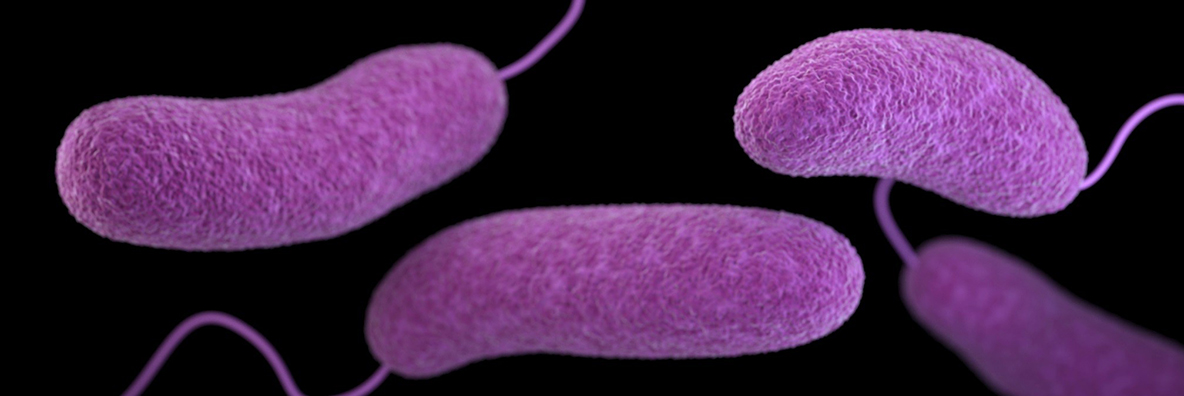Vibrio vulnificus is a type of bacteria that can cause a fatal infection. You get it from eating uncooked or undercooked shellfish or when seawater enters a wound. Symptoms get worse quickly. They include fever, low blood pressure and painful blisters. Go to the ER immediately if you think you have a Vibrio vulnificus infection and pray to God the attending physicians know what to look for before you need a limb amputating. Check on the CDC site for more details.
You may have heard that you can get Vibrio infection from eating raw or undercooked oysters and other seafood. But did you know you can also get a Vibrio infection through an open wound? Infection can happen when a wound comes into contact with raw or undercooked seafood, its juices, or its drippings or with saltwater or brackish water.
Vibriosis is caused by several species of bacteria, including the Vibrio vulnificus bacteria, which occurs naturally in saltwater coastal environments and can be found in higher concentrations from May to October when the weather is warmer. Infection with vibriosis can cause a range of symptoms when ingested, including diarrhea, stomach cramps, vomiting, fever and chills. Exposure can also result in ear infections and cause sepsis and life-threatening wound infections.
One species, Vibrio vulnificus, can cause life-threatening wound infections. Many people with Vibrio vulnificus infection require intensive care or limb amputations, and about 1 in 5 people with this infection die, sometimes within a day or two of becoming ill.
Some Vibrio vulnificus infections lead to necrotizing fasciitis, a severe infection in which the flesh around an open wound dies. Some media reports call this kind of infection “flesh-eating bacteria,” even though necrotizing fasciitis can be caused by more than one type of bacteria.
Who is more likely to get a Vibrio wound infection?
Anyone can get a Vibrio wound infection. But some people are more likely to get an infection and have severe complications—for example, people who have liver disease or take medicine that lowers the body’s ability to fight germs. Find out if you are at increased risk for infection.
How can I prevent a Vibrio wound infection if I have a wound?
You can reduce your chance of getting a Vibrio wound infection by following these tips:
- If you have a wound (including from a recent surgery, piercing, or tattoo), stay out of saltwater or brackish water, if possible. This includes wading at the beach.
- Cover your wound with a waterproof bandage if it could come into contact with saltwater, brackish water, or raw or undercooked seafood and its juices. This contact can happen during everyday activities, such as swimming, fishing, or walking on the beach. It could also happen when a hurricane or storm surge causes flooding.
- Wash wounds and cuts thoroughly with soap and water after they have contact with saltwater, brackish water, raw seafood, or its juices.
What are the signs and symptoms of Vibrio vulnificus infection?
Signs and symptoms of Vibrio vulnificus infection can include:
- Watery diarrhea, often accompanied by stomach cramping, nausea, vomiting, and fever
- For bloodstream infection: fever, chills, dangerously low blood pressure, and blistering skin lesions
- For wound infection, which may spread to the rest of the body: fever, redness, pain, swelling, warmth, discoloration, and discharge (leaking fluids).
How is infection diagnosed and treated?
Infection is diagnosed when Vibrio bacteria are found in the wound, blood, or stool (poop) of an ill person. The infection is treated with antibiotics. Doctors may need to amputate a patient’s legs or arms to remove dead or infected tissue.
Now it’s in New York (and Florida)
Vibriosis has been a nationally notifiable disease since 2007. This year so far there have been 5 deaths in Florida and three in New York. More at CBS.
Health departments report cases to the Cholera and Other Vibrio Illness Surveillance (COVIS) system. COVIS was initiated by CDC, FDA, and four Gulf Coast states (Alabama, Florida, Louisiana, and Texas) in 1989. By the early 2000s, almost all states were voluntarily reporting.
